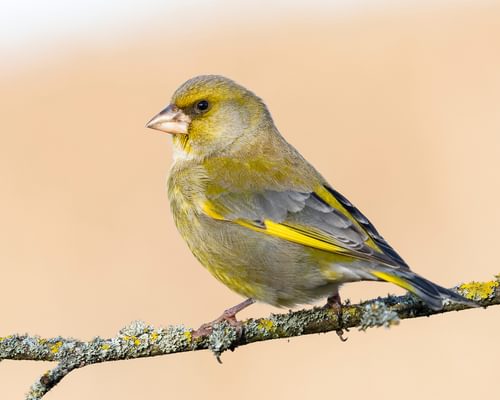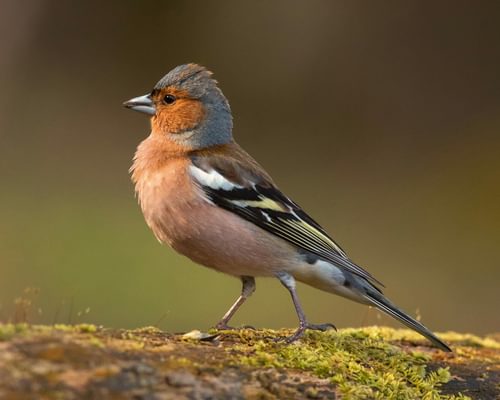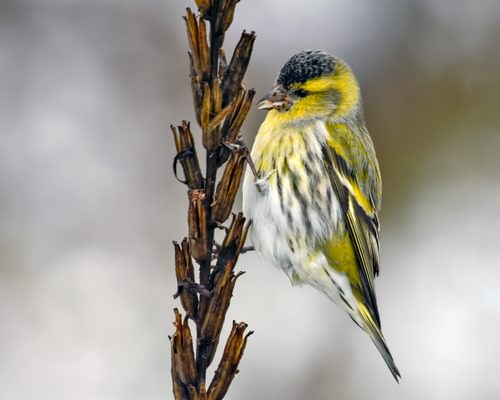Citril Finch
Least ConcernCarduelis citrinella
Visual Identification
Appearance
The Citril Finch is a small, vibrant finch with a distinctive greenish-yellow plumage. Its body is primarily olive-green, brightened by a yellow rump and breast. The wings and tail feature dark feathers edged with yellow, creating a striking pattern.
Males are more brightly coloured than females, with a more intense yellow on the face and underparts. Juveniles resemble females but have streaked underparts. The bird's appearance remains consistent year-round, with no significant seasonal changes.
Size
Length
12cm to 13cm
Wingspan
22cm to 26cm
Weight
11g to 14g
Colours
Males and females have similar plumage
Primary Colour
Green Yellow
Secondary Colour
Grey White
Beak Colour
Grey
Leg Colour
Pink
Habitat and Distribution
Habitats
Woodland
Garden
Wetland
Coastal
Urban
Farmland
Grassland
Desert
Tundra
Rainforest
Mountain
Savanna
Distribution
Citril Finches inhabit high-altitude areas of central and southern Europe, primarily in the Alps, Pyrenees, and other mountainous regions. They prefer coniferous forests, particularly those with spruce and pine, as well as alpine meadows and scrublands.
During winter, some populations move to lower elevations or more southerly areas. Their distribution is closely tied to the availability of suitable mountain habitats.
Elevation Range
800 to 2,500 meters
Climate zones
Alpine, Temperate
Distribution Map
This map gives you a rough idea of where you might spot a Citril Finch. The coloured areas show countries where these birds have been seen.
A few things to keep in mind:
- Birds might not be everywhere in the coloured areas, for example, they may be present around the coast of that country
- Where birds live can change with seasons and available food
- This map is quite simple - it doesn't show exact locations
We're working on making our maps even better! Soon, we hope to show you:
- More detailed maps for bigger countries, including state and region
- How birds move around during different seasons
Distribution by Region
Behaviour and Ecology
Bird Attributes
This feature is in beta. We'd love your feedback to improve it!
Share your thoughtsBird Attributes Explained
Our bird attributes system rates various aspects of a bird's capabilities on a scale of 0-100, based on data from field observations, scientific studies, and expert knowledge.
Attribute Categories:
- Agility: Manoeuvrability, speed, and grace in flight or movement.
- Strength: Physical power, often correlating with size and hunting abilities.
- Adaptability: Ability to thrive in various environments or changing conditions.
- Aggressiveness: Territorial behaviour and assertiveness, particularly during breeding seasons.
- Endurance: Stamina, often seen in migration patterns or foraging behaviours.
Understanding the Ratings:
- 0-20: Very Low
- 21-40: Low
- 41-60: Average
- 61-80: High
- 81-100: Very High
Remember, these attributes are relative to other bird species and don't necessarily indicate superiority.
Hover over the icon next to each attribute for more information.
Tap the icon next to each attribute for more information.
Agility
Reflects the bird's manoeuvrability, speed, and grace in flight or movement.
The Citril Finch demonstrates remarkable agility through its undulating flight patterns and ability to manoeuvre expertly amongst conifer branches whilst foraging. Their skilled seed extraction from cones requires precise movements and excellent balance.
Strength
Indicates the bird's physical power, often correlating with size and hunting abilities.
As a small finch weighing only 11-14g, the Citril Finch possesses modest strength relative to other birds. Whilst capable of extracting seeds from tough conifer cones, their physical power is proportionate to their diminutive size.
Adaptability
Represents the bird's ability to thrive in various environments or changing conditions.
These finches show impressive adaptability, surviving temperatures as low as -20°C and managing altitudinal migrations of over 1,000m. They adjust their diet seasonally and can shift their elevation range as needed, though they remain specialists of mountain habitats.
Aggressiveness
Measures the bird's territorial behaviour and assertiveness, particularly during breeding seasons.
Citril Finches are generally social and peaceful birds, typically seen in small flocks outside breeding season. Whilst males engage in courtship displays and aerial chases, they show limited aggressive behaviour compared to many other species.
Endurance
Reflects the bird's stamina, often seen in migration patterns or foraging behaviours.
Their ability to undertake significant altitudinal migrations, survive harsh alpine conditions, and maintain active foraging behaviour in challenging environments demonstrates solid endurance. Their capacity to raise multiple broods when conditions permit also suggests good stamina.
Diet
The Citril Finch primarily feeds on small seeds from conifers, especially spruce and pine. They also consume seeds from various plants, such as dandelions and thistles.
During the breeding season, they supplement their diet with small insects and spiders, particularly when feeding their young.
Behaviour
Citril Finches are social birds, often seen in small flocks outside the breeding season. They have an agile flight pattern, characterised by undulating movements.
When foraging, they skilfully cling to conifer cones and branches, extracting seeds with their specialised beaks.
Vocalisation
The Citril Finch's song is a pleasant, high-pitched warbling trill, often described as 'tsi-tsi-tsi-tsrrrrr'. Their call is a sharp, metallic 'tsit' or 'tswit', frequently given in flight.
During courtship, males produce a more elaborate and continuous version of their song.
Nesting & Breeding
Breeding season for Citril Finches typically begins in late April or early May. Males perform courtship displays, including singing and aerial chases, to attract females. Pairs form monogamous bonds for the breeding season.
Nests are built by the female, usually in conifer trees, well-concealed among dense branches. The nest is a compact cup made of twigs, grass, and moss, lined with feathers and plant down. The female lays 3-5 pale blue eggs with dark spots.
Incubation lasts about 13 days, primarily carried out by the female. Both parents feed the nestlings, which fledge after approximately 15-17 days. Pairs may raise two broods in a season if conditions are favourable.
Lifespan
The Citril Finch typically lives for 5 years, with a maximum recorded lifespan of 5.7 years.
Like all birds, lifespan can be affected by factors including predation, habitat quality, disease, and access to food sources.
Conservation and Status
Global Conservation Status
While the Citril Finch is currently listed as Least Concern, it faces potential threats from climate change affecting its alpine habitats.
Conservation efforts focus on preserving high-altitude coniferous forests and monitoring population trends in response to environmental changes.
Birdwatching Tips
- Look for Citril Finches in high-altitude coniferous forests and alpine meadows
- Listen for their distinctive trilling call, which can help locate them in dense vegetation
- Observe their feeding behaviour on conifer cones and seed heads of plants
- Visit suitable habitats in the Alps or Pyrenees during the summer months for the best chances of sighting
Additional Information
Quick Facts
Other names:
Alpine Citril Finch
Family:
FringillidaePredators
Main predators of Citril Finches include small raptors such as Sparrowhawks and Merlins, as well as corvids like Jays and Magpies.
Did You Know?
- Citril Finches have specialised beaks adapted for extracting seeds from conifer cones.
- They can survive in areas with winter temperatures as low as -20°C.
- Despite their small size, some Citril Finches undertake altitudinal migrations of over 1,000 meters.
Was this bird profile helpful?
Your feedback helps us improve our content
Thanks for your feedback!
Your input helps us improve our content.
Community Experience
Community Ratings
No ratings yet - be the first to rate this bird!
Latest Community Reviews
No reviews yet
Sign in to be the first to review
Community Reviews
Create Your Free Account Welcome Back!
Join our community to rate birds and share your experiences. Creating an account is completely free and only takes a minute. Sign in to your account to rate birds and share your experiences with our community.
Your information is secure and will never be shared.
By creating an account, you agree to our Privacy Policy.
Similar Birds
References
- 2 3 4
website: BirdLife International. 2017. Carduelis citrinella (amended version of 2016 assessment). The IUCN Red List of Threatened Species 2017: e.T22720062A111124877.
View source - 1
journalArticle, 2006: Moller, Sociality, age at first reproduction and senescence: comparative analyses of birds, J Evol Biol, 19:682-689
View source



